Wagner cast iron cookware is regarded by many as some of the finest examples of 19th and 20th century cast iron. Much of the cast iron is over 100 years old and still usable today. These antique pans are sought-after by enthusiasts who prefer vintage cast iron to newer pans. But identifying and dating these old Wagner Ware Sidney -o-pans can be tricky.
So, with this article, I hope to help you and other proud owners identify and give an estimate of the age of your cookware. You can also learn the history of your cast iron, which the Wagner Manufacturing Company manufactured.
Table Of Contents
- Wagner cast iron. “Why is it so collectible?”
- Learn the history of the Wagner Manufacturing Company.
- Where you can buy Wagner cast iron.
- Considerations when purchasing Wagner cast iron cookware.
- You can identify and date antique Wagner cast iron using trademarks and logos.
- Final thoughts on collecting vintage Wagner Ware cast iron.
But first, here is a quick look at the Wagner Manufacturing Company.
Identify And Date Your Wagner Cast Iron Skillets Using Logos. Also, Learn The Fascinating History Of Wagner Manufacturing.
Background To Wagner Manufacturing Cast Iron.
Founders | Milton M. Wagner and Bernard P. Wagner |
Operational Dates | The foundry in Sidney operated from 1891-1959 |
Located | The Wagner Manufacturing foundry was in Sidney, Shelby County, Ohio. |
Product Line | Wagner was one of the largest American manufacturers of cast iron products in the 20th century. Their product line included skillets, kettles, bean pots, Dutch Ovens, roasters, fruit presses, scoops, broilers, Griddles, waffle irons, muffin pans, and cornbread pans. The company also had a range of aluminum cookware. |
Wagner Brands | Wagner labeled their cookware under the following names: Wagner, Wagner Ware Sidney -o-, Wagner Ware, National, Long Life, Magnalite, Wardway, and Ward’s Cast Iron. |
Signature Products | Wagner is best known for the Sidney -O- range of skillets and Dutch Ovens. |
Reason For Closure | The reason for the closure of the foundry came from two fronts. Firstly, the Wagner family sold their interests in the company in 1953 to the Randell Company. Secondly, the company struggled financially because of a drop in sales. The decline in sales was due to two World Wars, the Great Depression, the development of new cookware materials, and the increase of lower-priced imports from Asia |
Wagner After Buyout (Non-Collectible) | In 1957, the Randall Company purchased long-term competitor Griswold from McGraw Edison. The Randall Company sold the cast iron businesses to Textron Corp in 1959. General Housewares Corporation bought Textron in 1969. In 1994, the production of Wagner Ware ended. |
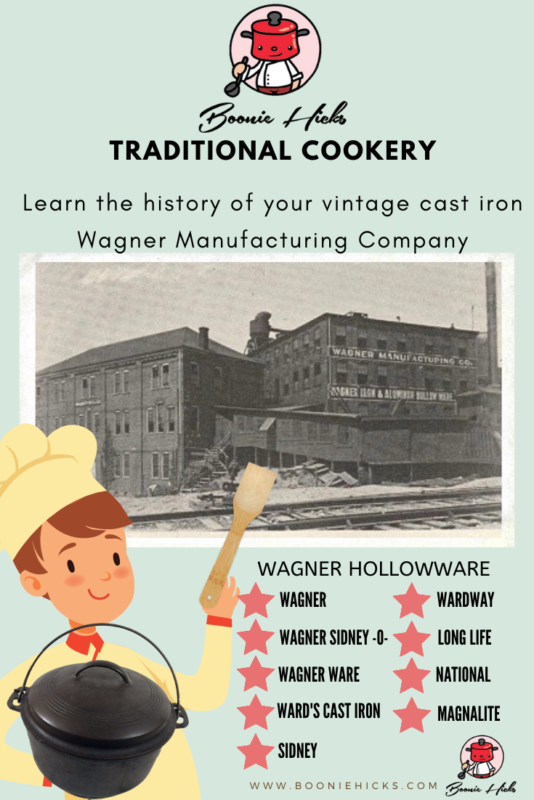
Why Is Wagner Cast Iron Collectible?
Super Smooth Cooking Surface.
Wagner cast iron is highly collectible. Like most antique cast iron, Wagner manufactured high-quality cookware for their entire range of cast iron products.
Unlike Wapak cast iron ironware, it often has characteristic casting flaws. Wagner cast iron tends to have a few casting flaws, resulting in very smooth cookware on both the interior and exterior of the cookware.
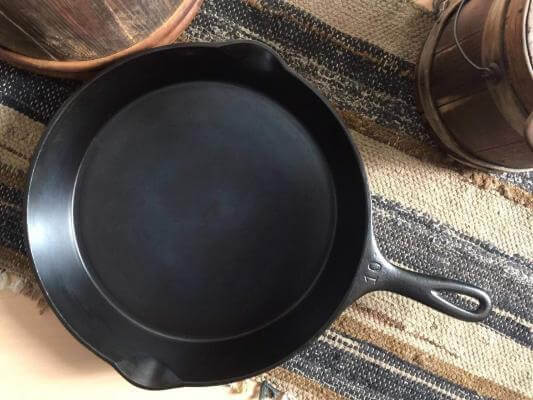
Focus On Quality
Imagine that workers would have worked on individual pieces of ironware. It was machined to smooth the interior and exterior of each pan. You can only see this level of detail in high-end cast iron cookware such as Le Creuset and Staub.
Today, Le Creuset and Staub benefit from combining traditional and modern manufacturing methods. However, the workers at Wagner could make cast iron cookware without casting flaws or bubbles. Must have taken great skill and attention to detail.
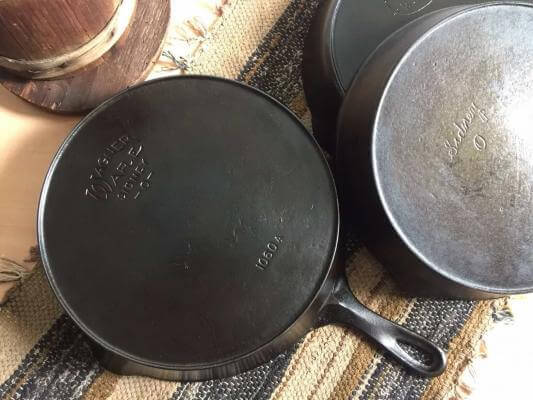
Wagner Made A Wide Range Of Cast Iron Cookware.
You can’t go wrong with an old Wagner cast iron skillet. It will serve you well for years, and they’re great fun. However, you may want to consider a Wagner Dutch oven. They are super smooth, and just like the skillets, they are reasonably priced. You can also buy cast iron muffin pans, which can be pretty cheap. But watch out for shipping costs that can increase the overall price drastically. Some of Wagner cast-iron cookware range includes:
- Dutch ovens
- Griddles
- Gem pans
- Waffle irons
- Skillets
You can even collect Wagner cast iron cornbread pans that look like corn cobs. Wagner Manufacturing also produced aluminum cookware, which must have seemed revolutionary.
Collect Your Favorite Logo.
If you want a vintage skillet, then Wagner skillets are a great choice. You can choose from sixteen different logos and trademarks or markings. I like pans with heat rings, while others may prefer a pan with a smooth base.
I think this wide selection makes Wagner cookware more collectible than other manufacturers, such as Vollrath and Martin Stove and Range, which manufacture a limited range of products.
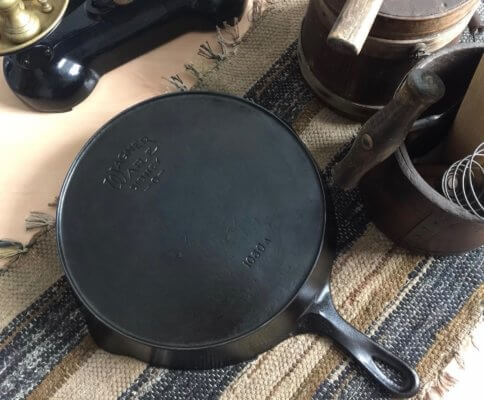
Wagner Manufacturing Company Focused On Quality Over Quantity.
Quality was a focus from the very start for Wagner Manufacturing Company. They even advertised this selling point to consumers. Old advertisements read;
We do not strive to manufacture hollowware as cheaply as possible but as well as it can be made. We cannot afford to put on the market ware that will not sustain our reputation. The name Wagner is on the bottom of each piece of ware.
Wagner Manufacturing Company History
Founders And Foundry
Who Founded Wagner Manufacturing? | Wagner Manufacturing Company was founded in 1891 by Milton M. and Bernard P. Wagner. However, two more Wagner brothers, Louis and William Wagner, joined the company in the following years. Another key player in the foundation of the company was R. Bingham. Bingham previously worked at Marion Stove Company and the Sidney Manufacturing Company. |
Where Was Wagner Cast Iron And Wagner Ware Made? | The company had its ironworks in Sidney, Shelby County, Ohio. Early cookware from Wagner Manufacturing had a simple Wagner marking on the back of the ironware. Wagner included Sidney O. in their cookware around 1895. The term Wagner Ware first appeared in the logo in the 1920s. |
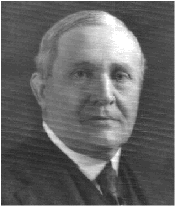
The Wagner Product Line Added Nickel Plating, Aluminum, And Magnalite.
Nickel-Plated Cast Iron | To complement their cast iron range, Wagner added a nickel-plated range. Unlike cast iron and copper pots, nickel plating does not react to acidic foods such as tomatoes, which can taint food. It’s easy to look past the development of nickel-plating. But, in the 19th century, bonding two metals together would have required much metal casting expertise. |
Aluminum Cookware | Along with nickel-plated cast iron, the Wagner brothers in 1894 manufactured a line of aluminum cookware, and Wagner Manufacturing was one of the first companies to do so. |
| Aluminum Cookware Exported To Europe | By 1913, Wagner cast iron and aluminum products were selling in Europe. |
| Magnalite | In the 1930s, Wagner manufactured a cookware line with a patented aluminum alloy called Magnalite. |
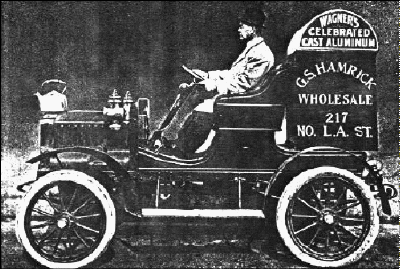
Wagner Manufacturing Buys Their Sidney Competition.
| Wagner Bought Sidney Hollowware Company. | In 1897, Wagner bought the Sidney-based competitor Sidney Hollow Ware Co. from the founder and owner Phillip Smith. Sidney Hollow Ware made high-quality cast iron cookware that was extremely light and smooth. Sidney Hollow Ware Co. was also an early adopter of nickel-plating cast iron. |
Why Did Wagner Buy Sidney Hollow Ware Company? | It was a brilliant idea to buy the Sidney Hollow Ware Company. After all, Wagner Manufacturing and Sidney competed in the same city and made comparable products. However, it was common knowledge that Smith made a tidy profit from his original investment in the foundry. To run the Sidney Foundry, William H. Wagner joined the family business to oversee the operation. |
Wagner Sold Sidney Hollow Ware Back To Phillip Smith. | In 1903, Wagner Manufacturing sold the Sidney Hollow Ware Company to the founder, Phillip Smith. Sadly, Phillip Smith did not reopen the foundry due to health reasons. |
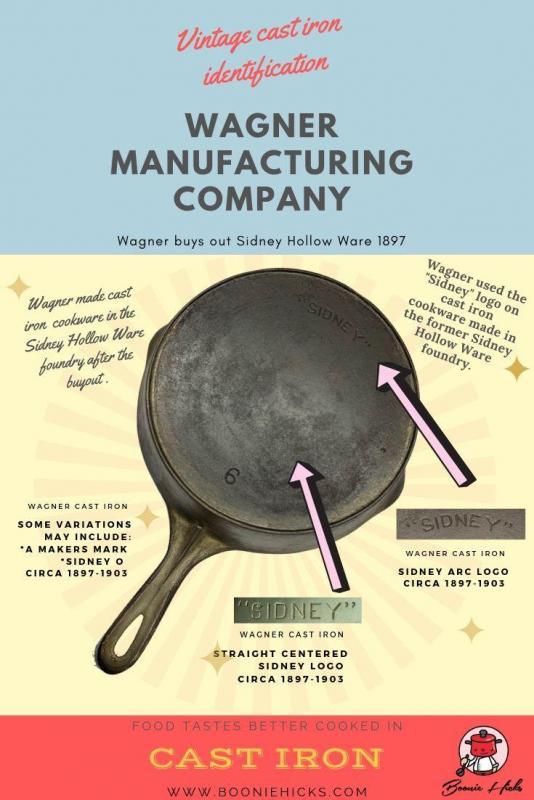
Wagner Introduced A New Product Line To Stop A Decline In Sales.
| The Great Depression (Magnalite) | I have to take my hats off to Wagner because they introduced a new product line called Magnalite in one of the deepest recessions the world has ever seen. Wagner Manufacturing was steadfast in making only quality products. For this reason, the cookware is collected and highly usable. |
| The Sales Decline | Wagner introduced Magnalite to stop falling sales at Wagner Manufacturing; it was not due to their product range. Magnalite was hugely popular, but it could not offset the effect of the worldwide recession. From 1929-1941, the US was in the grips of what we now call the Great Depression. Therefore, it was not only Wagner. However, many foundries struggled financially to survive. Many didn’t. |
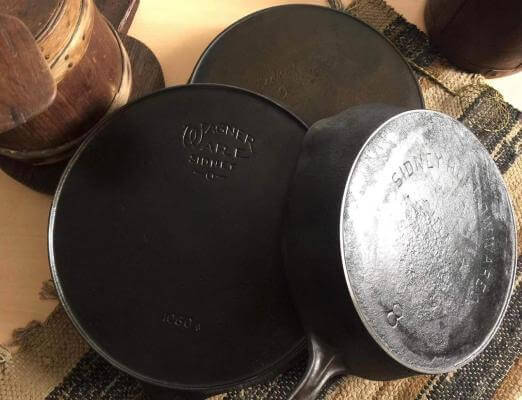
The Family Sells Their Interest In The Foundry.
Wagner Family Sells The Company To Randall Corp. | Wagner Manufacturing Co. lasted longer than many foundries. However, in 1952, Wagner was sold to the Randall Company. Unbelievably, the Randall Company was a car parts manufacturer. |
Textron Buys Randall | In 1959, another business called Tetron bought Wagner. Textron also purchases Griswold Manufacturing Company. At this date, cast iron enthusiasts consider this the end of Wagner Ware production. Wagner cast iron pans made after this date are considered not collectible. |
General House Wares | General Housewares Corporation in 1969 bought the rights of Griswold and Wagner. |
Is Wagner Ware Still Made? | With the world rediscovering cast iron cookware, will we see Wagner Ware skillets manufactured again? General Houses Ware stopped the manufacture of Wagner Ware in 1994. However, there is a glimmer of hope for Wagner Ware. In 2014, American Culinary bought both the Wagner and Griswold trademarks. So, fingers crossed, cast-iron fans may one day decide to manufacture Wagner cast iron again. |
Where Can You Get Your Hands On Some Wagner Ware?
- Grandparents (best deal and great to keep your heritage in the family).
- Antique stores (check online to compare the store price).
- Garage sales (rescue those poor skillets from the tip).
- Flea markets (search the markets for hidden gems).
- Online (largest selection available; however, asking prices can vary greatly.
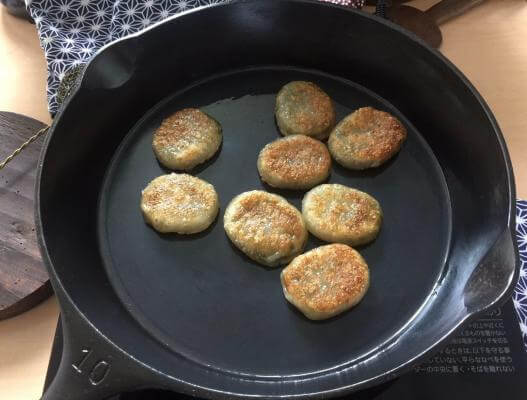
Buying Considerations Before You Buy Antique Wagner Ware
There Is Plenty Of Wagner Cast Iron Around, So Take Your Time.
There is no shortage of Wagner cast iron. Wagner had a large percentage of the cookware market back in its heyday. And plenty of fantastic Wagner skillets and Dutch ovens are in excellent condition.
What Size Skillet Or Dutch Oven Suits Your Needs?
The first thing you may want to think about is the size you need. There are often plenty of #8 skillets around. This size seems to be the most common for Wagner skillets and other vintage cast iron manufacturers, such as Favorite Piqua.
Inspect Carefully Since A Lot Of Wagner Ware Is Nickel-Plated.
Check the cookware carefully. The Wagner Manufacturing Company was an early adopter of nickel plating. However, most of Wagner cookware is unplated iron. Heavy seasoning may hide nickel plating. Nickel-plated can wear off or be patchy in places. Take a close look before purchasing.
Would You Like A Wagner Ware Skillet With A Smooth Bottom Or Heat Ring?
Do you want a pan with a smooth bottom or one with a heat ring? The older Wagner Ware skillets will have a heat ring, while the later-made pans have a smooth, flat base. It is a personal preference. I tend to like the older skillets with heat rings. They have more character, but the smooth-bottom Wagner cookware tends to be a little cheaper. And they are great cooking pans, too.
Does The Cookware Sit Flat?
As with all antique cast iron, asking the seller if the pan sits flat could be a good idea. A lever base is practical if cooking on a flat surface such as induction or glass.
Learn To Date And Identify Your Wagner Cast Iron Using Logos And Markings.
Although I’ve researched carefully, please only use the dates as an approximation.
Wagner cast iron cookware, to my knowledge, has sixteen known logos, brands, or markings. These include:
Straight Wagner Logo 1890s-1915
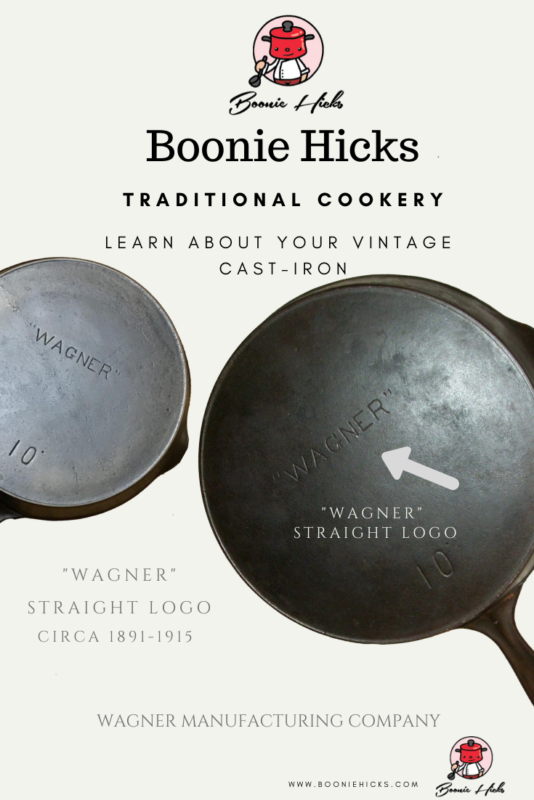
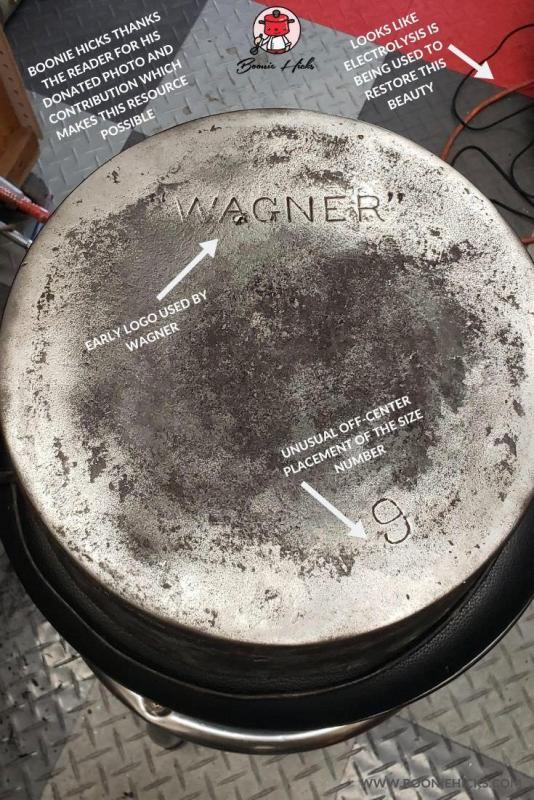
Wagner Arc Logo 1891-1910
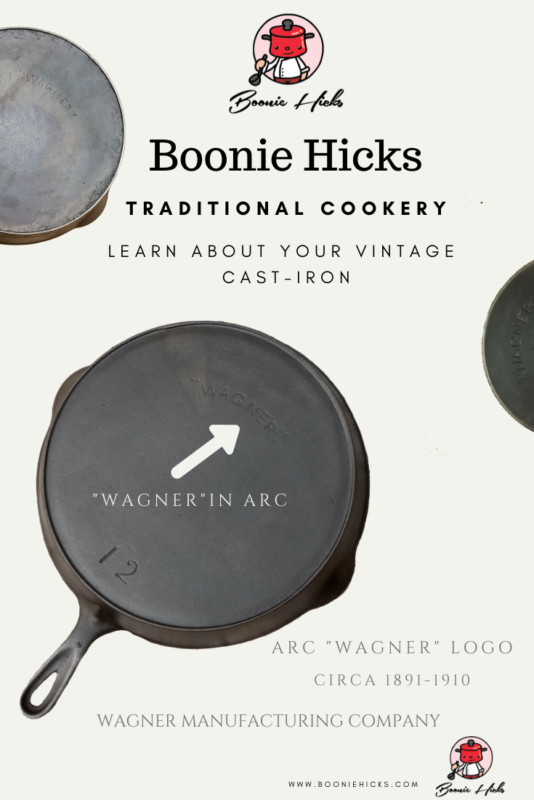

Double Arc Wagner Sidney O 1895-1915
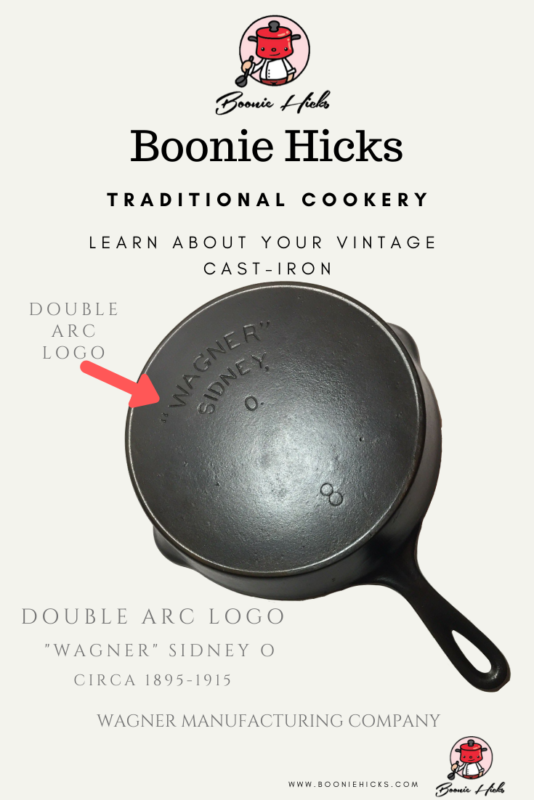
Sidney Arc logo Circa 1897-1903.
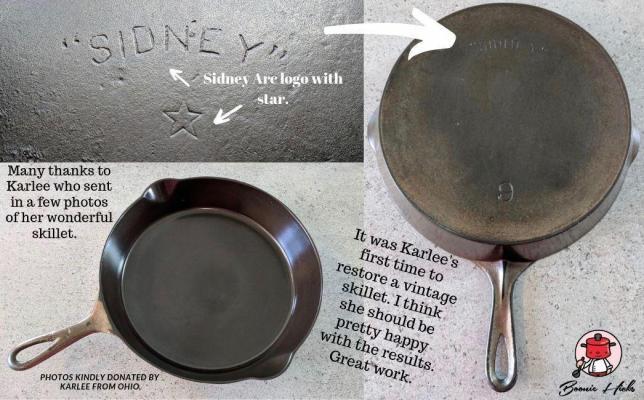
Straight Sidney Logo Circa 1897-1903.
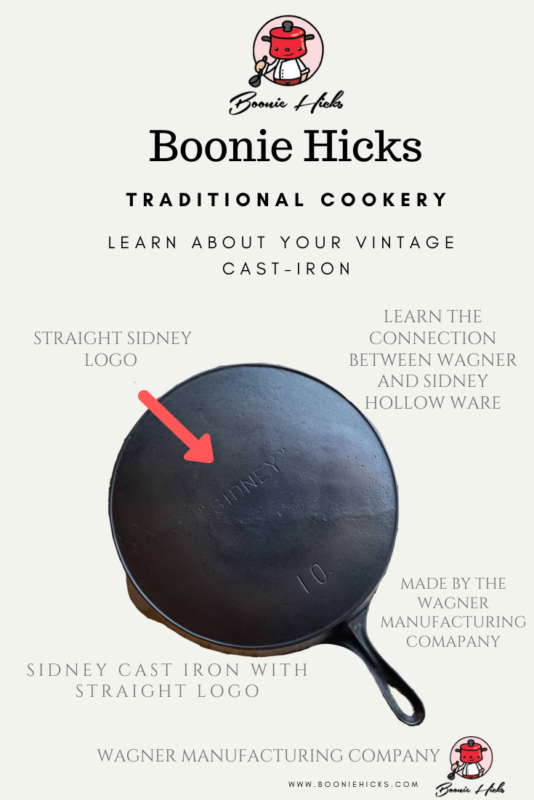
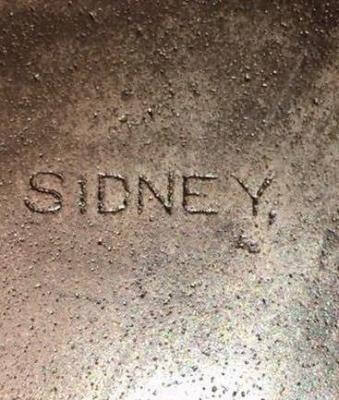
Straight Wagner Sidney O. (Centered.) 1910-1915
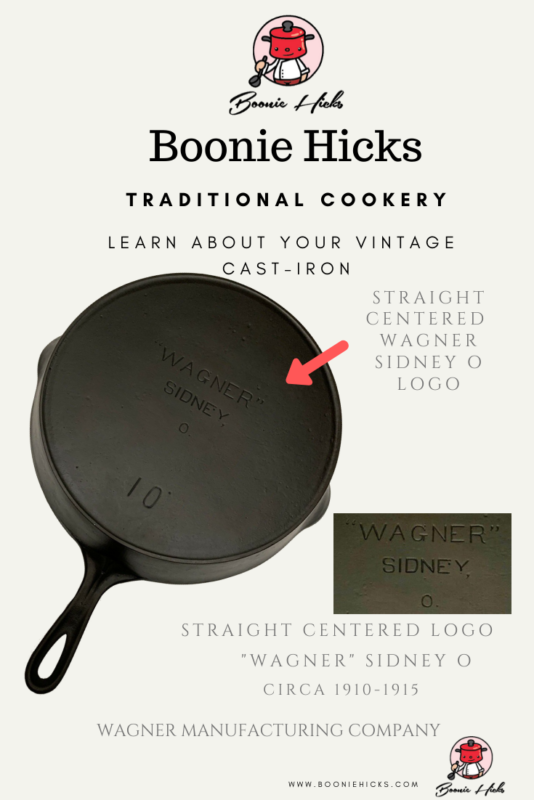
Wagner Sidney O. Wagner Slightly Arced While The Sidney Lettering Is Straight. Circa 1915-1920s
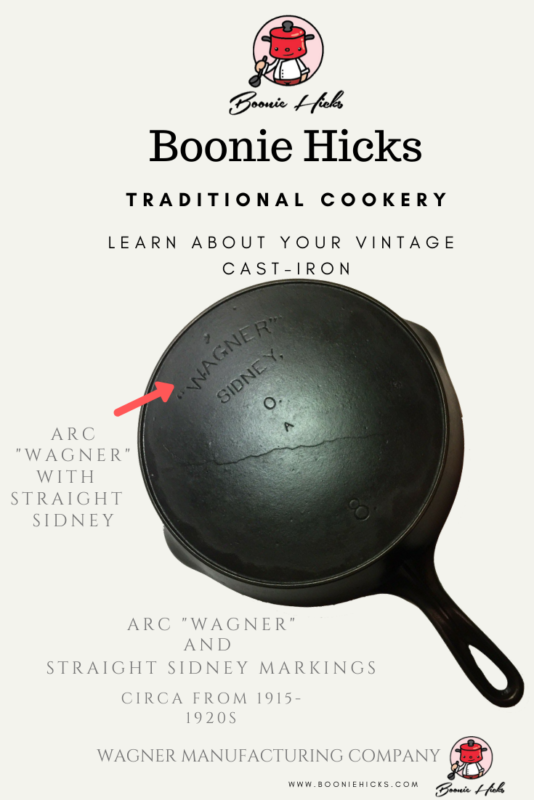
First Wagner Ware Sidney O. With Arc Wagner And Straight Ware And Sidney. Circa 1920s.
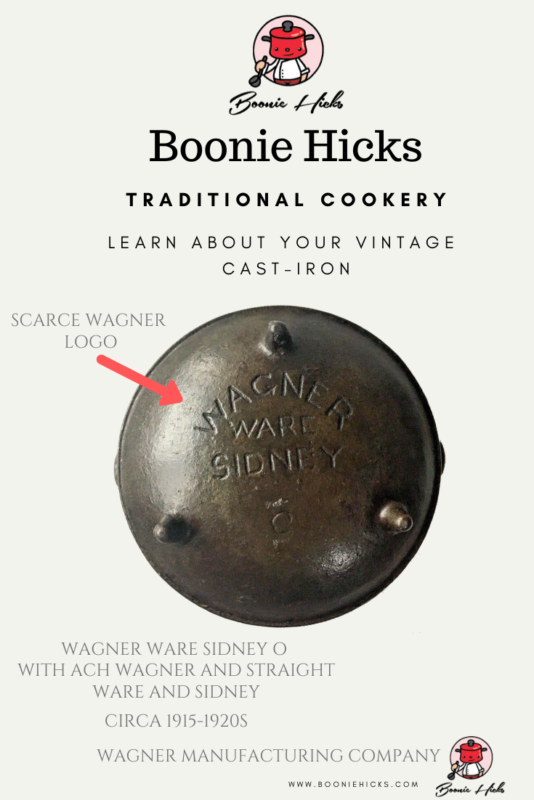
Stylized Wagner Ware Sidney O. for regular skillets. Circa 1920-1924 with heat ring and single-digit size number. 1924-1935 with a heat ring and a four-digit pattern number. Around 1935-1959, for skillets with no heat ring.
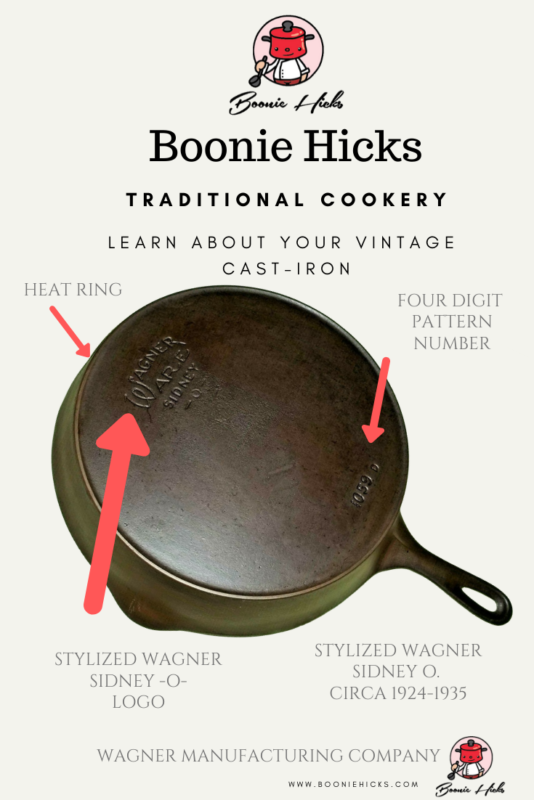
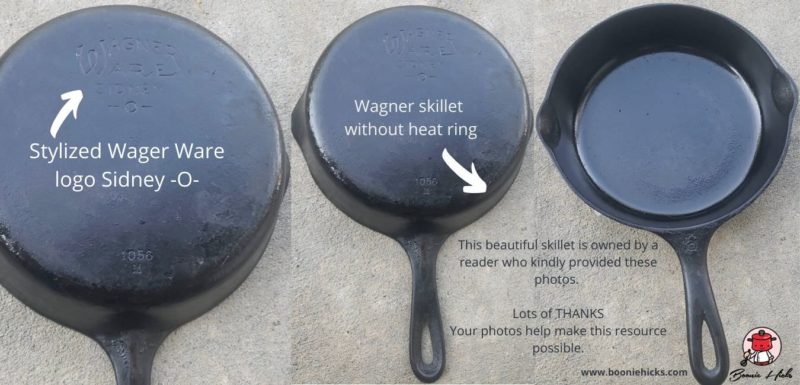
Centralized Stylized Wagner Sidney O. 1924-1935 With Heat Ring.
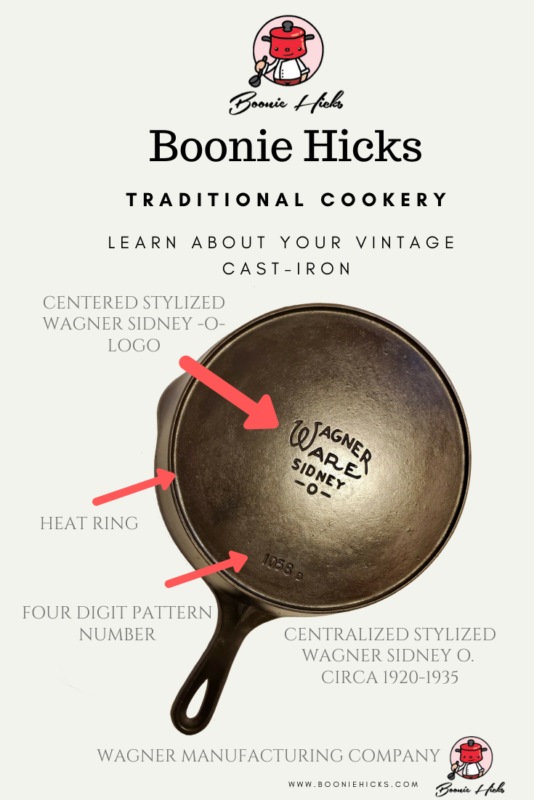
Pie Logo 1924-1934. However, Manufacturing Dates Are Uncertain.
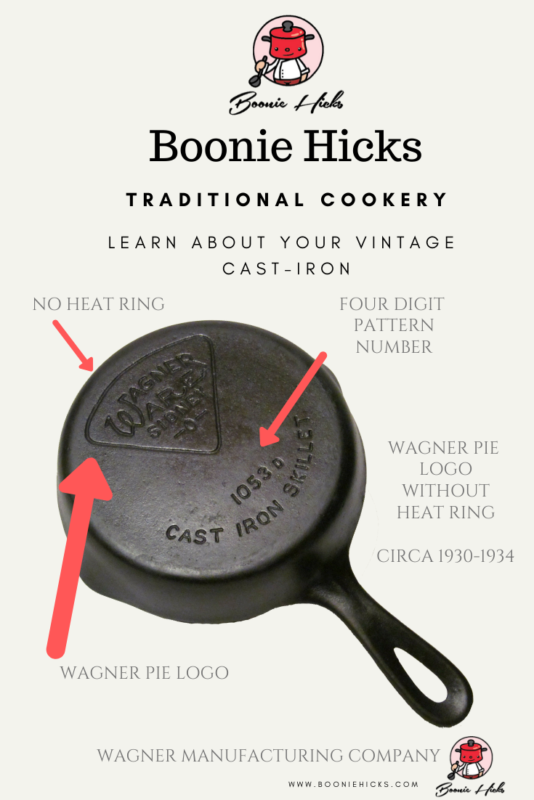
National Cast Iron Dates Between 1914 and 1940s
There are several different versions of cast iron with the National marking. Wanger marketed the Nation brand as entry-level cookware for budget-conscious consumers. Wagner made the National line circa 1914 to 1940.
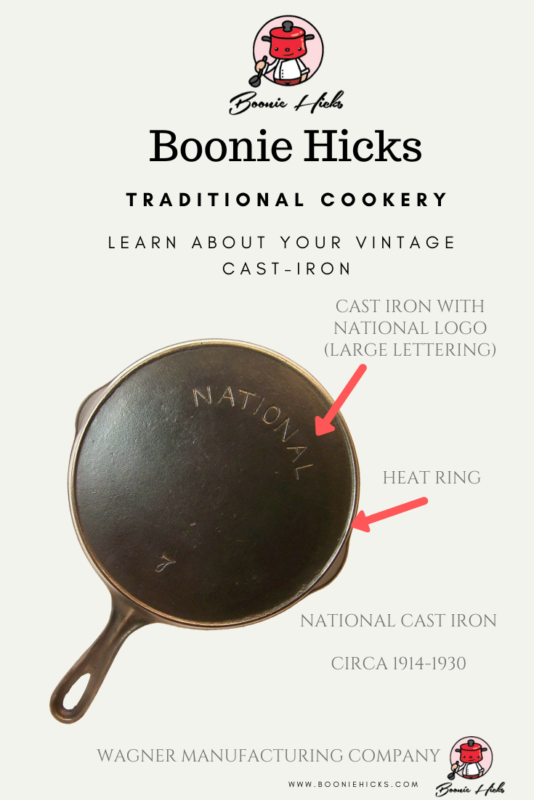
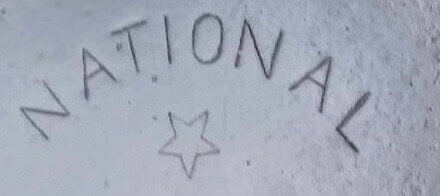
Long Life Logo 1930s.
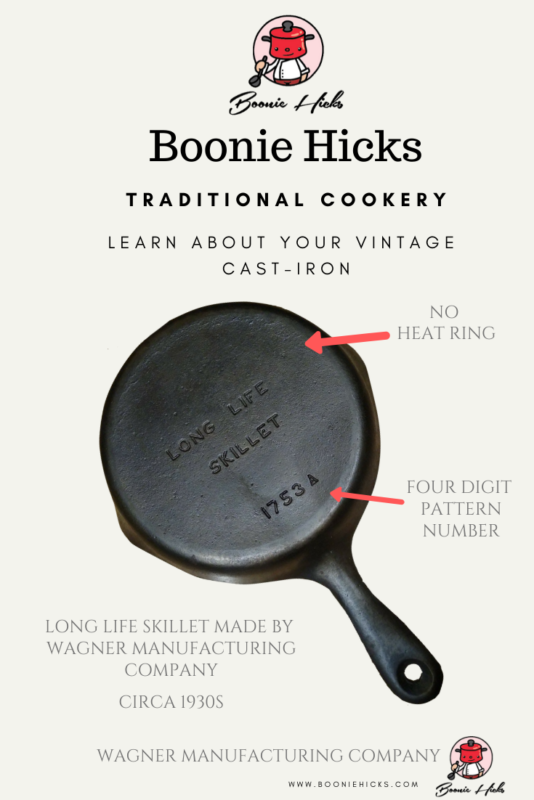
Wardway and Montgomery Ward. The Montgomery Ward Department store contracted Wagner Manufacturing Company to produce an in-store label. Circa the 1930s.
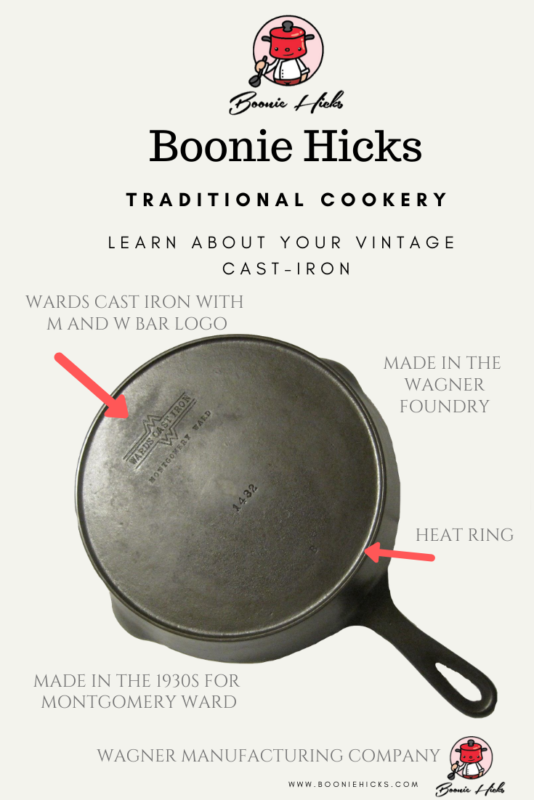
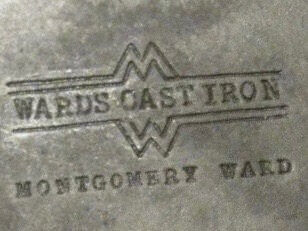
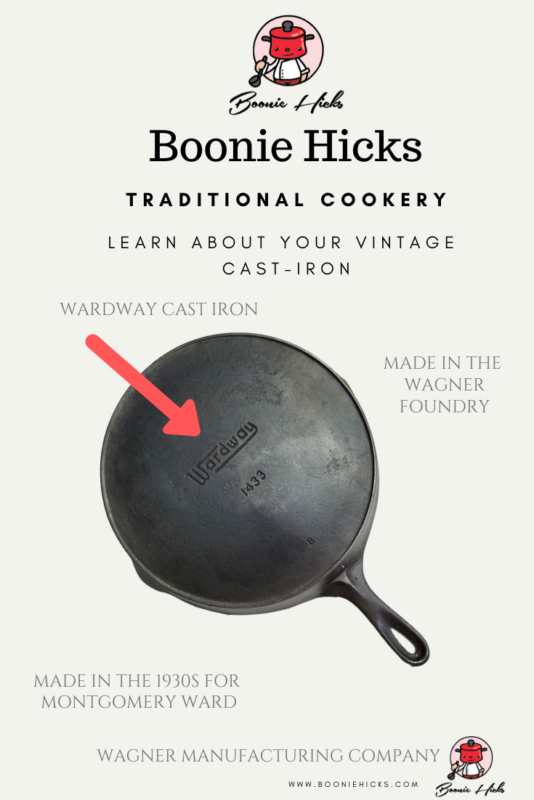
Final Thoughts On Wagner Cast Iron.
Fortunately, Wagner cast iron is more straightforward to date than other foundries of the time. Wagner Ware also has a huge collector base, so dates are well documented. The Cast Iron Collector is a valuable online resource for enthusiasts. Also, there are Facebook groups where you can share your love of cast iron cookware.
The Wagner Manufacturing Company was known for quality over quantity. Therefore, it has a good reputation for making trustworthy products.
Today, collectors and enthusiasts seek out Wagner cookware. However, you don’t need to be a collector to enjoy vintage cast iron. Here are six reasons why Wagner Ware is excellent ironware.
Although many cast iron enthusiasts look for Wagner-made skillets. But you’re not limited there. Wagner Manufactures a wide selection of cast iron cookware. You may find yourself becoming interested in:
- muffin pans
- Dutch ovens
- Scotch bowls
Since Wagner made some of the finest cast iron of the 19th and 20th centuries, Wagner ironware is still sought-after by cast-iron fans and hobbyists alike.

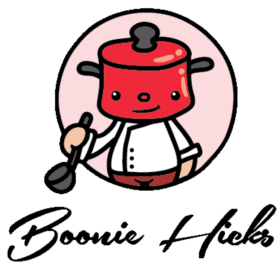
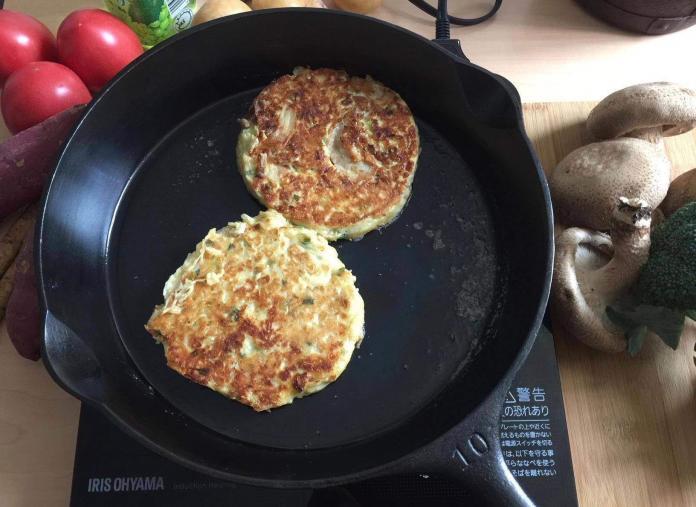
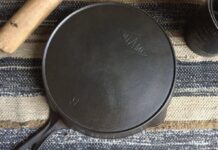
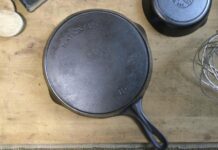
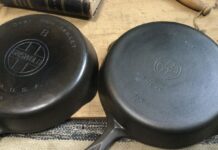



I have a griddle that belonged to my great great grandmother marked with only a w on the bottom. I was trying to find the history of it. Would the w be for Wagner or something else? I know it is quite old
Hi Penny
Thanks for getting in touch. These unmarked pieces are certainly old.
There is some speculation some ironware with a single raised letter on the base (in the 6 o’clock position) was manufactured by Lodge. And made before the introduction of the Lodge logo. However, this can’t be verified, and many collectors simply identify these pieces as “mystery.”
You have a neat piece of cast iron history.
I just got a Wagner Ware with the following markings.
* National on the top (away from the handle) in a curve, all caps.
* Stylized Wagner-Ware Sidney -O- in the middle
* 1357 on the bottom
* 7 on the handle on the top side.
* Has a heat ring
Except for the National marking this would seem to be a 1924-1934 model from your article. You mention National as a budget brand, but then it has all the other main markings too. Would this have been a cheaper materials skillet from that 1924-1934 era? What made National a budget brand?
Hi Larry
National skillets are fantastic old pans. There is however slightly variations in the logo as you have noticed. But it seems like you have identified your skillet correctly.
Although Wagner branded National cast iron as a lower-cost option, there’s no discernible difference in quality. The skillets often go under the radar from collectors. But they are just as smooth as any Griswold or Wagner skillet. It sounds like you made a great purchase.
Have fun.
I have a large kettle mfg by Wagner. It is light and aluminum color and has a bail handle. On bottom is fire ring. Name WAGNER in a curve and under is SIDNEY ,straight line and under that is O Then Down at bottom of kettle is stamped 20 QT Can I get any date of mfg. or value. Harold Wall
Hi Harold
Thanks for getting in touch. When is comes to Aluminum Wagner kettles my knowledge is limited.
However, large cast iron kettles of the same description date from the late 1890s to the mid-1910s. And I suspect Wagner was also producing cast aluminum cookware during this time. Without a pattern number it definitely sounds like an early piece. I would get a second opinion to be on the safe side.
Hope this points you in the right direction.
Did Wagner Ware make any wall match safe?
My friend said her grandfather worked there in Sidney and they stamped these at the factory . She has two with a hunting theme .
They are not marked Wagner and I am skeptical .
I see cast wall match safe on internet searches ,but nothing leads me to Wagner.
.
Thanks
Hi Brenda
Wagner manufactured a lot of goods that we consider unusual today. Match holders and striking plates were common during the late 19th and early 20th-century, But I’m unaware of Wagner ever producing them. It’s a neat piece of history if they are from the foundry.
Thanks for sharing.
Hello, thanks for the information. Did they Wagner Ware Sidney O with heat ring also come nickel plated. Or a nickel-plated handle? If so, how is the quality of these pans compared to regular cast iron?
Hi Tonya
Yes, they sure did.
However, it’s a little unusual just to have the handle plated. It’s likely the seasoning on the handle has simply rubbed off over time, making the platting visible.
Nickel plated skillet as not as collectable, but this does not mean lower quality. Undoubtedly, the skillets had to pass quality control before the coating was applied.
Hope this helps.
Hi Boonie
Really nice job on this site! Fascinating stuff. I have some Wagner cast iron pans 8, 9, 10 from my dear old Auntie that she said were passed down from my grandfather. I can remember eating fried eggs and bacon from his cast iron pans in the 50s. But I have some doubts if mine are those. All of them have 5 line cast iron seasoning instructions. I don’t see any examples like that here and it strikes me as more “modern” touch. Would you know more about that?
Kindest regards,
Bill
Hi Bill,
Thanks for getting in touch. I need to research these pans, as there is little information on when General Housewares Corporation first introduced them to the market. However, as a rough and conservative estimate, your pans are from the late 1980s-to the mid-1990s.
Hope this helps
Boonie
Thanks for your reply.
I suspect you are right, the story of these pans was probably muddled in translation! I do love them all the same and they are in constant use to this day. I kinda think if you have any pan, appliance or tool that has been in use for 30-40 some years you are onto something good 🙂
Regards,
Bill
Hi Boonie,
We have an 8” skillet that says National at the top of the back, Wagner ware Sidney O in the center, and 1358c at the bottom. 50s era? Thanks for the great article!
Hi Wayne,
There are a few subtle variations on Wagner Nation skillets. But it sounds like yours is circa 1930-1940s. They are beautiful looking skillets and hard to find.
Have fun
Thank you so much for this wonderful article.
I was watching a TikTok and they were talking about Wagner iron. It got me Googling more about the history of the cookware and I came across your article. Because I had such a passion for cooking as a teen and young adult, my grandmother left her collection to me as an inheritance. It seems as if my collection is from 1924-1935. It’s really cool to be able to give a little more history about my pieces of iron. As I used to cook along side my Grandma in the kitchen,
I also used this cookware to cook with my son. He’s grown and out of the house, but when he visits, he’ll still whip out Grandma’s cast iron to cook what he raided from my refrigerator lol. I’m planning to make a batch of cornbread this weekend when he comes by to visit so I’m excited to share some more info about our family’s cookware.
Hi Drew
Thanks for sharing your cast iron passion with us. Treasuring heirloom ironware is a great way to remember our families and heritage. And it’s fantastic you could research and identify your family Wagner Ware through the site.
Have fun making cornbread with your son.
Hi so excited hope you can please help me have been trying to research this piece .Looks like a water pitcher ? Says Wagner wear Sidney -0 then the number 410 as well hope can help me thank you 😊
Hi Linda
My knowledge of the Wagner aluminum range is limited. However, I can confirm you have Wagner 4 Quart water pitcher. As a rough estimate on age, a lot of the Wagner Aluminum Ware seems to from the 1920s-1930s.
Hope this helps
Hi Boonie!! Thank you for your fun research! I have a 10 1/2 inch Skillet made in the USA and on top it’s got the fancy W used for both “Wagner” and “ware and nothing else. Can you tell me anything about this sweet skillet?
Hi Don
I’m really happy that you’re enjoying your vintage Wagner. It’s not an ultra old piece, and it’s likely from the 1960.They are not as collectable as older pieces, but they are just as smooth and are great pans to use.
Enjoy your vintage pan.
I have an unmarked skillet. The top sid of the handle has an 8 on it while the bottom side has a P on it. There is not a heat ring. The only marking on the bottom is 10 1/2 INCH SKILLET. Could this be a Wagner? If so, what might the manufacturer date be ? Thanks
Hi Debbie
It sounds like you know your vintage cast iron. And I think you could be right with your assumption. Wagner marked unbranded ironware at the bottom, including size and used a lettering system for quality control. I’d say you have a Wagner skillet. Great work identifying an unmarked piece.
Happy cooking
Hi. I have a Wagner Ware Cornstick cast iron pan. Wagner ware is written fancy, Made in USA then a D at the bottom. What can you tell me about this??
Hi Karlie
You have a later Corn Stick pan made after 1960. It was made buy a company called General Housewares Corporation. This company bought Wagner Manufacturing after the last Wagner family members sold the controlling stake in the company.
It’s not a scarce or highly collectible piece, but it should make some great cornbread.
Have fun
Boonie Hicks,
I found your website very interesting and informative.
My pan has the Wagner Ware logo with the single W (Wagner is curved, “are” is straight) Sidney O, 10B, it has a heat ring, the logo looks like the ones you have in the 1924-1935 range. But mine does not have a 4 digit pattern number, just 10B. Would you put this in the 1924-1935 time period?
Thank you.
Karen Booth
Hi Karen
Thank you so much, I’m really happy that you have found the site useful.
Your pan is a little earlier than the example I provided. The Wagner Ware stylized logo without a pattern number is circa 1920-1924. They are beautiful pans, you’re very lucky.
Hope this helps, and fun cooking.
Found a Wagner Ware corn mold for cornbread in the free bin at a garage sale. The only markings on the back are the stylized Wagner Ware logo and the letter C. There’s no Sidney though…could you tell what date range these were made?
Hi Megan, luck you.
I need to do more research in modern Wagner Ware. But if your skillet has a stylized logo without Sidney O, it’s likely made by General Housewares. Probably circa the 1960s to early 1970s.
It’s a great find, and I’m sure it will clean up nicely. Have fun.
Hi,
Just to clarify the mold designation lettering. We have two identical Wagner #5 skillets with the stylized Wagner Ware Sidney O logos, no heat ring, 1924-1959 vintage. One has a 1055 at the bottom, the other 1055H. So, the one with the H would be older, as they were marking it with the mold to ensure that specific mold had no manufacturing issues? Later on, there would be no letters used? Thanks.
Thanks for getting in touch.
Wagner was a large manufacturer of cast-iron cookware and had a production line. Therefore they produced many skillets and needed many molds at the same time. So, unfortunately, we can not use the letters after the pattern number to older pans.
I hope this answers your question. Enjoy your Wagner skillets.
I have a Wagner Ware Sidney -O- 1058 A. Just curious, does the ‘A’ make it a rare piece or more desirable, as it may have been the first mold?? I haven’t seen other A models offered for sale or discussed online. Thanks for your help.
Hi Brett
Unfortunately, the mold lettering system adds no value or collectability to the pan. It is likely Wagner used many molds on the manufacturing line at any given time. So it doesn’t hold the first production status. Nevertheless, it’s pretty cool, and you’re lucky to have a skillet using mold A.
Have fun using your vintage Wagner.
Hi Boonie,
I have a miniature Wagner Sidney O. 1910 waffle iron (4″) with a baled stand. What can you tell me about it. Is it a salesmen’s piece or is it a toy? Also do you know a estimated value?
Thanks!
Hi Marty
I’m not a collector of cast iron toys or miniatures. But I believe this particular item has productions often sold as the real McCoy. Handles on an original item should have grooves in the handle from woodworkers lathe like a standard handle. And the iron should be smooth.
Often reproductions have poorly cast iron and short stubby handles. For current valuations, check out the sold listings on eBay.
I trust this points you in the right direction.
I have a Wagner Ware Sydney O Bacon and Egg breakfast skillet. The number stamped on the underside is 1101 L Pat Pending. This piece is likey late 20’s?
Hi Richard
I think you’re spot on with the approximate date of manufacture.
Enjoy your skillet, I’m sure it cooks up a great breakfast.
I found a Wagner Ware International Chili Society Official Chile Kit Cast Iron Lid . I can not find and information on it . Could you tell me a little bit about it . Thanks
Hi Steve
This Wagner is an unknown piece to me, and I had to do a little research myself. I wonder if it was used as official cookware in a cooking competition by contestants or possibly official merchandise by the club.
I found a couple of Google images paring the International Chile Society marked lid with a dual logo Wagner and Griswold Dutch oven. And could help find a possible date of manufacture of circa 1970-1975, and manufactured by the General Housewares Corporation.
Well done on your find.
Hi Boonie
I’ve always had an iron skillet.. Love ,love, love them.
I have a number 8
Wagner Ware,
Sidney O.
1058 Z
I am assuming it between 1920s and 1950s. My question is what is the Z letter on the skillet? I’ve always wanted to know.
Thank you,
Hi Sam
Thanks for getting in contact. And it sounds like you have a Wagner with a stylized logo. That’s a fine piece of vintage ironware.
Think of the letter following the four digits as an early production code. Wagner used the letters to identify the mold used to make your skillet. If there were quality control problems during production, workers could identify and remove any mold causing issues.
Trust this helps, and have fun using your skillet.